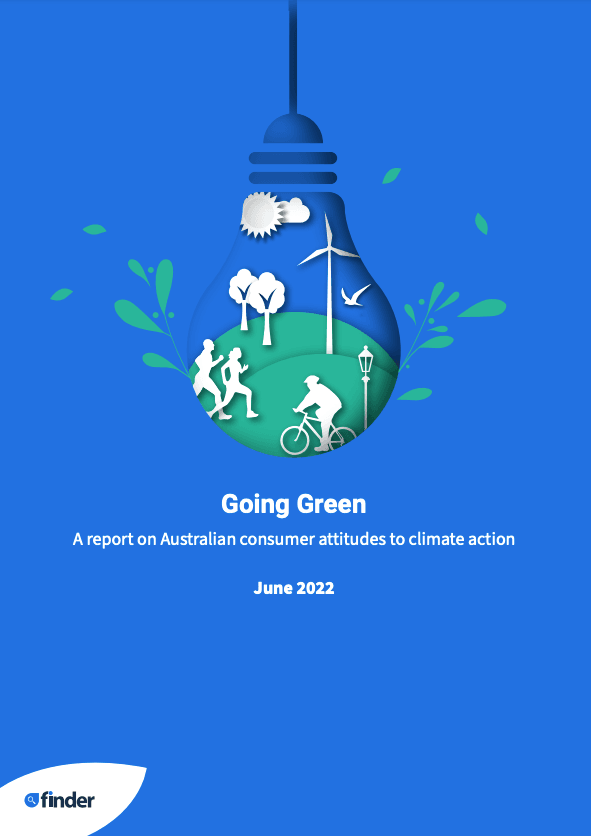Going Green: A report on Australian consumer attitudes to climate action
 Australians have had a front-row seat to the devastating consequences of climate change over the past few years, from the summer bushfires of 2020 to the recent floods in the eastern states. Despite the pandemic, climate change has become increasingly front-of-mind for consumers and in politics.
Australians have had a front-row seat to the devastating consequences of climate change over the past few years, from the summer bushfires of 2020 to the recent floods in the eastern states. Despite the pandemic, climate change has become increasingly front-of-mind for consumers and in politics.
Our report finds Australians are more concerned about the environment than they were one year ago, and are more likely to make sustainable changes in their lives. Interestingly, we find the largest improvements in green attitudes and behaviours are among those who are statistically more averse to or sceptical of environmentalism: men, older generations and regional dwellers.
We explore the drivers of eco-friendly behaviour, how social influence can be used to reshape consumer behaviour in today's hyper-connected world, and some of the challenges associated with going green. We analyse how much money different sustainable behaviours could save consumers, as well as their environmental benefits. We draw on insights from Finder's team of experts on how consumers can make small changes that benefit their finances and the planet in one fell swoop.
You can access the full report here.
Key findings
- Nearly 9 in 10 Australians (88%) have reduced their environmental impact in some way.
- Using less plastic (62%), using energy-efficient appliances (44%) and installing energy-efficient lighting (42%) are the most common sustainable practices.
- Women (75%) and gen Z (83%) are the demographic groups most concerned about their carbon footprint.
- Men (66%) and baby boomers (55%) are the least concerned about their carbon footprint.
- More than half of Australians (57%) are more mindful of their environmental impact since COVID-19.
- 1 in 2 Australians actively looks for greener products or services.
- Concern about climate change (73%), wanting to feel good about personal choices (57%) and setting a good example for others (48%) are the top reasons people choose green products.
- Switching to a sustainable super fund could save the average worker an annualised $6,490 per year over a 45-year period.
Concern for the environment is growing
Since releasing last year's Green Consumer Report 2021, Australians have become more concerned about the planet. We compared the year ending April 2022 to the year ending April 2021, and found the percentage of people who are not at all concerned about their carbon footprint dropped from 35% to 31%. The percentage who are extremely concerned increased from 12% to 14%.
How much does it cost to go green?
Making sustainable changes does not have to be expensive. Finder analysis found a number of green choices could actually save money, and some of the simplest switches have the largest impact on carbon emissions.
The Finder Green Awards help consumers make more sustainable choices
While our research found most Australians are concerned about their carbon footprints, three in four (76%) agree it's hard to know which products or services are truly better for the environment.
Fortunately, Finder has done the hard work through the Finder Green Awards, which highlight the top companies paving the way in sustainability. From superannuation to cleaning products, the Awards are a great place to start for those looking to switch to environmentally friendly alternatives.
Visit the Finder Green Awards hub page to see the list of winners in 2024.
Download Finder's Green Consumer Report 2022.
Ask a question
More guides on Finder
-
Renting vs. Owning in Australia
Finder's Property Investment Index predicts price growth in each suburb across Australia's major cities.
-
Economic snapshot: 4 things to watch this month
Get up to speed with the latest economic update, offering insights into Australia's financial landscape.
-
Finder’s Cost of Living Pressure Gauge
Finder's Cost of Living Pressure Gauge measures the financial stress experienced by Australian households.
-
Finder’s Economic Positivity Index
Tracking the outlook of Finder's panel of economic experts.
-
Finder Consumer Positivity Index
Tracking how Australian consumers feel about the economy and their financial lives.
-
Finder’s Property Investment Index Hobart
Finder's Property Investment Index predicts price growth in each suburb across Australia's major cities. Find out how your suburb stacks up.
-
Finder’s Property Investment Index Adelaide
Finder's Property Investment Index predicts price growth in each suburb across Australia's major cities. Find out how your suburb stacks up.
-
Finder’s Property Investment Index Perth
Finder's Property Investment Index predicts price growth in each suburb across Australia's major cities.
-
Finder’s Property Investment Index Brisbane
Finder's Property Investment Index predicts price growth in each suburb across Australia's major cities.
-
Consumer Sentiment Tracker
Discover average home loan sizes around Australia and much more with our comprehensive guide to home loan statistics.
